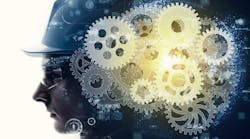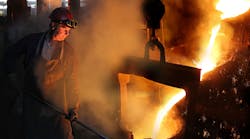Latest from Plant Operations
Manufacturing plants and warehouses can be massive—not to mention extremely complex to run.
Site managers already have their hands full overseeing day-to-day operations, preventing injuries, and protecting the property from crime. On top of this, today’s managers often must juggle their core responsibilities with additional compliance duties, as new health regulations continue to emerge in response to the changing COVID-19 crisis.
How is it possible to get everything done when you’ve only got two eyes, two arms, and only so many hours in a workday? Many companies are turning to artificial intelligence (AI)-enabled live video surveillance cameras for help.
Dynamic Duo: Live Video Surveillance and AI
You’re probably familiar with standard “record-and-store” cameras that record hours of footage for playback at a later date. These conventional cameras provide video evidence of crimes and compliance issues after they happen, which is better than nothing.
But, what if you could deter crime and rectify compliance gaps in real-time before any damage can be done? Thanks to the powerful combination of live video surveillance and AI, you can.
Contrary to standard cameras, live video surveillance systems provide a 24/7 video feed that can be accessed anywhere, anytime—so companies benefit from real-time surveillance and response.
AI consists of smart machines—e.g., smart cameras—capable of performing tasks that typically require human intelligence. AI can analyze volumes of data (such as video feeds) and detect and act on things in real-time—alerting a security team to a person breaking into a warehouse, for example.
AI can also “learn” over time, the same way humans learn when they do a deep dive on a topic, so it becomes more precise as time goes on (e.g., distinguishing between people, animals, and inanimate objects when monitoring a property for suspicious activity).
When AI is paired with live surveillance, companies are able to enact a proactive approach to security and compliance that enables business owners and management teams to react to issues as they’re happening.
To give you a better idea of how this works, here are three ways in which AI-enabled live video surveillance can help manufacturing organizations and warehouses step up security, health, and safety measures:
1. Detect and Deter Crime
As I mentioned, with standard security cameras, people have to review recorded footage after a crime has already taken place. While this might help catch the culprits at a later date, the damage has already been done by the time someone is reviewing.
AI-enabled live video surveillance systems, however, provide round-the-cloud monitoring and response that enables companies to deter crime. AI software can be trained to spot suspicious behaviors such as someone arriving on-site after hours, entering an “off-limits” area, or hopping a fence.
When suspicious behavior is detected, the system alerts a team of security professionals who can then trigger audiovisual deterrence features, such as strobe lights, sirens, and even live or recorded announcements. In many cases, this scares off would-be criminals before they can do any harm to the premises.
2. Monitor Workplace Compliance
From employees wearing hard hats and safety glasses on factory floors to the proper operation of forklifts within a warehouse to social distancing requirements, there are endless local, state, and federal workplace health and safety guidelines that manufacturing plants and warehouses must follow—and the list is only growing as a result of COVID-19.
In many cases, it is extremely difficult to monitor compliance manually. But ignoring compliance or just “taking your chances” aren’t viable options either, since violations can result in serious injuries, expensive fines, potential site shutdowns, and a loss of employee and customer trust.
AI-enabled live surveillance introduces a world where management can get a much-needed helping hand. These systems can be trained to spot compliance gaps—such as an employee without a hard hat—and immediately alert management, so they can react in real-time.
Additionally, with AI-enabled live surveillance systems, managers have the ability to pull up live video feeds from their smartphone, so they can conduct compliance and safety checks remotely, at any time.
3. Detect and Mitigate Health Risks
As the COVID-19 pandemic has progressed, many local and state leaders have imposed mandates related to social distancing, occupancy limitations for businesses, and the use of personal protective equipment (PPE). In a plant or warehouse setting, these things can be difficult to track.
Here too, AI-enabled live video surveillance can come to the rescue. These systems can do things such as:
- Measure the space around workers to determine if they are within the required social distancing guidelines, and alert management when guidelines are being violated,
- Count how many people are coming into and going out of a building, and
- Detect employees and customers who aren’t wearing face masks or other PPE.
When paired with thermal imaging technology, these systems can even spot employees running fevers before they come into contact with others, so they can be separated and undergo further evaluation.
At a time when limiting contact between humans has become the norm, AI can provide solutions to help monitor potential health threats to keep them from becoming a problem in the workplace.
In today’s evolving environment, manufacturing and warehouse management teams need to maintain tight control over operations, even if they can’t be on-site. AI-capable live surveillance systems make this possible, without having to invest in armies of personnel to identify and remediate safety and compliance violations. And, of course, it will also perform its time-tested mission–preventing crime before it happens.














